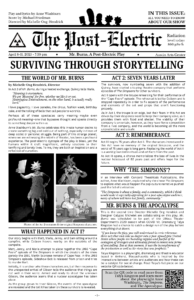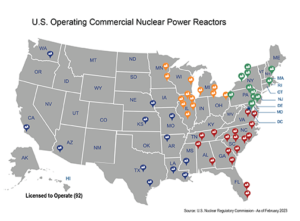Mr. Burns, A Post-Electric Play
Play and lyrics by Anne Washburn
Score by Michael Friedman
Directed by Michelle Ong-Hendrick
Tues-Fri, April 9-11 (7:30 PM)
Goodwin Theater, AAC
Mr. Burns, A Post-Electric Play” is presented by arrangement with Concord Theatricals on behalf of Samuel French, Inc. www.concordtheatricals.com.
In Anne Washburn’s darkly funny, grandly operatic Mr. Burns, survivors of a nuclear apocalypse may not have much, but they have Bart Simpson, Sideshow Bob, and Gilbert and Sullivan. Gathered around a campfire, they piece together the plot of a “Simpsons” episode from memory. It’s the first moment of a people establishing a culture through storytelling, and we sing, laugh, and struggle along with the characters as this mainstay of classic pop television, mashed up with songs, contemporary memes, and TikToks, becomes the foundation of a new mythology and artistic tradition. What follows on this page offers context for some of the play’s references …

THE POST-ELECTRIC:
THE OFFICIAL NEWSPAPER OF
MR. BURNS, A POST-ELECTRIC PLAY
In lieu of a program for this production,
The Post-Electric contains a synopsis of each act,
and information about the creative team and performers.
FREE FALLING INTO HISTORY, BY TALYA KINGSTON
This is the second time Director Michelle Ong Hendrick and Designer Calypso Michelet are collaborating on this play. Mr. Burns was scheduled to be part of the UMass Theater Department’s 2020 season when COVID hit. Dramaturg Talya Kingston had a chance to catch a design run of the play before everything shut down:
“If you know the play, you will understand its eerie relevance: three acts that each take us deeper into a post-apocalyptic United States where people are hoarding supplies and fearful of the contagion of strangers and ultimately forced to invent new forms of storytelling. But at that moment, it was the incompleteness of the production as well as the story that was prophetic.”
Talya Kingston is a playwright, dramaturg, and theatre educator based in Amherst, Massachusetts, who is inspired by the interactions between artists and audiences and how these can be a catalyst for social change. Read Talya’s full piece HERE.
ANNE WASHBURN, PLAYWRIGHT

Playwright Anne Washburn and others share thoughts on “The Simpsons,” workshops, and theater in this behind-the-scenes look at Mr. Burns, A Post-Electric Play.
Anne Washburn’s plays include Mr. Burns, The Internationalist, A Devil At Noon, Apparition, The Communist Dracula Pageant, I Have Loved Strangers, The Ladies, The Small and a transadaptation of Euripides’ Orestes. Her work has been produced by 13P, Actors Theater of Louisville, American Repertory Theatre, Cherry Lane Theatre, Clubbed Thumb, The Civilians, Dixon Place, Ensemble Studio Theater, The Folger, London’s Gate Theatre, Playwrights Horizons, NYC’s Soho Rep, DC’s Studio Theater, Two River Theater Company, NYC’s Vineyard and Woolly Mammoth. Awards include a Guggenheim, a NYFA Fellowship, a Time Warner Fellowship, Susan Smith Blackburn finalist, and residencies at MacDowell and Yaddo. She is an associated artist with The Civilians, Clubbed Thumb, New Georges, and is an alumna of New Dramatists and 13P. Currently commissioned by MTC, Playwrights Horizons, Soho Rep, and Yale Rep.
“CAPE FEARE,” SEASON 5, EPISODE 2, THE SIMPSONS

Why The Simpsons? What makes The Simpsons so culturally significant?
The Simpsons, first airing in 1989, became a cultural phenomenon because it revolutionized animated television with its sharp satire, unique characters, and its blending of high and low culture. Unlike the cartoons we had known before, it wasn’t just for kids; it tackled social issues, politics, and everyday life with humor that appealed to both casual viewers and hardcore fans.
At its peak, The Simpsons wasn’t just a TV show; it was the TV show, influencing comedy, pop culture, and even the way people spoke.

